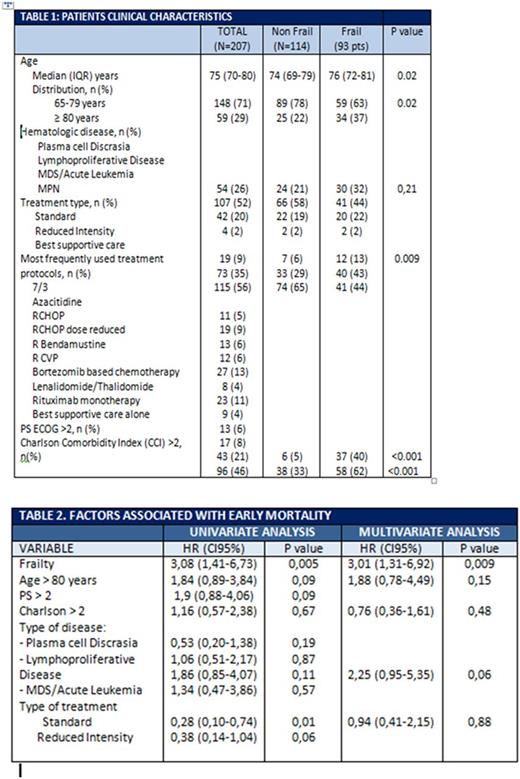Abstract
Introduction: Onco-Hematologic neoplasms occur predominantly in older population. These patients are often offered reduced intensity treatments, facing worse outcomes, because of under-treatment, increased toxicity or early death (1). Multiple publications propose that comprehensive geriatric assessment can help adapting treatments to avoid functional decline, treatment toxicity, and even death. We developed a global geriatric assessment evaluation performed by geriatricians: DRIPP.
Objectives:
Primary objective: To evaluate predictors of early mortality (defined as mortality at 3 months)
Secondary objective: To evaluate frailty prevalence in patients with hematologic malignancies referred for a geriatric global assessment.
Materials and Methods:
We performed a prospective cohort study between October 2014 and May 2017. Patients were included consecutively. DRIPP was performed by geriatricians in the outpatient and inpatient setting, and utilizes two different frailty scales: Edmonton and Fried. Patients were defined as frail if there were considered so at least in one of both scales. We considered T0 as date of DRIPP evaluation. Descriptive basic statistic was performed. Chi2 and Ttest were used for population comparison. Cox regression model was used for univariate and multivariate analysis for survival at 3 months. Patients were followed from DRIPP date till death or lost to follow up. The study complies with guiding principles for experimental procedures found in the Declaration of Helsinki.
Results: A total of 216 patients were evaluated by DRIPP. Nine patients were excluded from analysis due to lack of clinical data. Two hundred patients (97%) presented follow up more than three months and were included for analysis. Median follow up for the entire cohort was 13 months (IQR 6-21 months). Clinical characteristics are shown in table 1. Frailty prevalence in our population was 45% (93 patients, CI 95% 38 - 52). Frailty was associated with higher age, worst PS and higher CCI. During the first three months of follow up, 31 patients died: 22/93 patients of the frail group and 9/114 patients in the group without frailty. Mortality rate for the entire cohort during the first three months was 15% (CI95%10-20): 24% (CI95%15-33) for the frail group and 8% for non-frail (CI95% 4-14) (p=0.002). Most patients died due to disease related events. Univariate and multivariate analysis are shown in table 2. Frailty was associated with early mortality at 3 months in multivariate analysis after adjusting for age, comorbidities, type of disease and treatment. Though not statistically significant, presence of MDS/acute Leukemia showed an increased risk for early mortality in multivariate analysis (HR 2.25 (CI95% 0.95-5.35) p=0.06).
Conclusions: There was a high prevalence of frailty in our patient´s cohort. The most important factor associated with early mortality was frailty, regardless of age, comorbidities, type of disease and treatment. These results emphasize the importance of performing a geriatric evaluation in elderly patients with hematologic malignancies
Fantl: Raffo: Speakers Bureau; Janssen: Consultancy, Speakers Bureau; varifarma: Consultancy, Speakers Bureau. Schutz: varifarma: Speakers Bureau.
Author notes
Asterisk with author names denotes non-ASH members.


This feature is available to Subscribers Only
Sign In or Create an Account Close Modal